L. David Roper (roperld@vt.edu)
(www.roperld.com)
On 15 June 2004 Jean Marie Pergrin Starr sent to me the following message by e-mail:
Hi, you don't know me but I'm supposed to be related to Benjamin Franklin. I have family silver ware with the Bache name on it, quite a few pieces. ... I have quite a few paper clippings, very old, about the relatives of Ben and a not complete family tree written a long time ago just by the hand writing. Could you help me with this? I'm willing to let someone do DNA on the tooth but I don't know where to start.... PS I have a hand written marriage certificate circa 1835 for Enos Pergrin.
In my web page Benjamin Franklin's DNA I had mentioned that I would like to find a tooth of Benjamin Franklin to test the Y-chromosome in its DNA. I had placed an ad in the Philadelphis Inquirer seeking male Franklins to test their Y-chromosomes and for a possible tooth of Benjamin Franklin, which led to a column by Michael Klein in that newspaper on 3 December 2002:FranklinDNAPhillyInq.htm. This led to a story by David Caruso published across the United States by the Associated Press: AssociatedPress.pdf.
However, Jean Starr had not seen any of those articles. As the administrator of her mother's estate, she came into possession of the items she mentioned after February 2004 when her mother died. When she found time, she searched the Internet for any information about Benjamin Franklin and any archives about him. She notice my name and e-mail address, so she contacted me with the message given above.
Since Jean Starr's message to me, she and I have had many communications. She took some pictures of the tooth, which are shown below. Jean has the following in their possession:
| Pictures of the tooth in its gold-acorn case taken by Jean Marie Pegrin Starr. | |
There is apparently a crack down the middle of the tooth, but perhaps the roots, from which DNA can be extracted, are intact. The two halves of the tooth are severed from each other and are rather loose in the packing, especially the smaller piece. Also, the packing, apparently old paper, is very loose.
All of these items were handed down through the generations in the possessors' family. Their existence in the possession of one famiy with strong genealogical evidence of descendancy from Benjamin Franklin, statesman, is strong evidence that the tooth probably is a tooth of Benjamin Franklin.
I wonder if Benjamin Franklin (BF) might have preserved the tooth himself, since he was a scientist par excellence and must have had some ideas about inheritance of traits. He also had a strong sense of U. S. history and his place in it. His half-brother, Samuel, was a blacksmith, so he could have made the gold-acorn. If not BF, then who would have preserved the tooth, if it is indeed BF's tooth? It is unlikely that it was a dentist who did it, since the tooth remained in the family. My guess is that it was in Ben's artifacts when he died and was passed on to his daughter, Sarah Franklin Bache, and then on down the line, finally to the current possessors. Ben was certainly astute scientifically and historically enough to know that his tooth would be important to preserve. In his autobiography (Benjamin Franklin's autobiography) he wrote "It has ever since been a pleasure to me to see good workmen handle their tools; and it has been useful to me, having learnt so much by it as to be able to do little jobs myself in my house when a workman could not readily be got, and to construct little machines for my experiments, while the intention of making the experiment was fresh and warm in my mind."
Another possibility has occurred to me: Benjamin Franklin was one of the founders of The Pennsylvania Hospital in Philadelphia. It could be that the hospital gave Benjamin one of his teeth encased in a gold acorn in appreciation for his efforts at founding the hospital.
A dentist, Dr. Gary L. Glasband of Long Beach, California, has examined the tooth and determined that it is human. He looked at it through a loop and determined that there is a small rivet at the top holding the acorn rim to the acorn body. However, it appears that the rim is soldered to the acorn body in some places; so, removing the rivet would probably not allow the rim to be taken off of the body. There are what appear to be two places where something was soldered to the acorn on opposite sides of the rim at 90 degrees to the rivet. Could it be a Benjamin Franklin design? Perhaps he wanted to make it easy for some future generation to remove the tooth to get genetic material from it. Here is the Dr. Glasband's report, slightly edited:
Thank you for the opportunity to examine the remains of the tooth you brought in. In my opinion the tooth is human in appearance and my guess is that it is a lower left second molar. It appears to have carious destruction of the clinical crown which probably caused its previous owner to have an abscess and a resulting toothache. In the time of Ben Franklin root canal treatment would not have been available; however, an extraction could have been performed. --- Unfortunately the metal (gold acorn) thwarted my attempts to radiograph the tooth and see the root anatomy which would have allowed me to positively identify the tooth. I know you are going to have DNA testing performed on the tooth. Because of your family relationship to Ben Franklin I suspect that this is an authentic specimen. Closer inspection of the watch fob under higher magnification (see 2nd picture below) seems to indicate that the tooth can be removed intact by loosening the small screw on the side and removing the top of the fob. The tooth is packed in with some inert wadding material. Also, note the tooth appears to be mechanically fractured in two pieces. --- Thank you allowing me to be the first dentist to inspect the tooth. Sincerely, Gary L. Glasband, DDS, Long Beach CA, 22 June 2004
Another dentist in Blacksburg Virginia, Dr. John K. Robertson, later examined the tooth and stated that part of the side of the tooth had been broken off, perhaps before it was pulled or when it was dropped as a part of a watch fob.
I think that the two solder joints are where a watch-fob chain was attached, so that the tooth would hang with the crown up when it was worn as a watch fob. The solder joints may have been broken in the past, allowing the tooth to fall and crack it and perhap chip a side off of it.
Mr. Kevin L. Slusher, an estate appraiser in Roanoke Virginia, met with L. David Roper on 21 July 2004 to examine the gold acorn. The following points summarize what he told LDR:
This tooth was reputedly pulled from the mouth of Benjamin Franklin (1706-1790), statesman. If this is so, It was passed down 7 generations as follows:
The tooth is inside a gold acorn with some loose fibrous packing around it. The tooth is broken into at least two parts. Dr. Gary L. Glasband, a DDS in Long Beach CA , has identified the tooth as probably a human lower-left second molar. Apparently one side of the tooth was broken off in the past, possibly before it was pulled.
Jean Marie Pergrin Starr contacted L. David Roper about the existence of the tooth on 15 June 2004. She loaned the tooth to LDR on 15 July 2004 in order that some analyses could be done and so that LDR could take the tooth to University of Louisville to begin the process DNA extraction in late August 2004. The tooth was put back together after the roots were removed. It was returned to Jean Marie Pergrin Starr at Houston TX on 29 October 2004.
On 29 August L. David Roper (LDR) took the tooth to the laboratory, at University of Louisville, of Dr. Christopher R. Tillquist, Assistant Professor of Anthropology, for the tasks for removing the tooth from the gold acorn, cutting the roots from the crown of the tooth and for a later attempt to get DNA from the roots. This procedure and the subsequent attempt to get DNA from the roots was financed by Family Tree DNA (http://www.familytreedna.com) through the efforts of its CEO, Bennett Greenspan.
The original plan was that the roots would be cut from the tooth by a very thin saw blade. However, after some discussions of LDR with Dr. David Browdy, a medical dentist in Lynbrook NY and a member of the Board of Directors of The Friends of Franklin, Inc., it was decided to consider using a Waterlase (http://www.biolase.com/waterlase.html) dental device to do the cutting. Dr. Browdy arranged for a Waterlase device to be delivered to Dr. Tillquist's lab by its maker Biolase Technology, Inc. (http://www.biolase.com).
Bennett Greenspan brought with him to Louisville John Miller, a videographer, to record the procedure of removing the tooth from the gold acorn. Biolase Technology, Inc. arranged for a camera crew from a PR firm in Louisville to be there for a similar purpose, especially the part involving the Waterlase.
Before the tooth-removal procedure began LDR made the following remarks:
| Gentleman: Now that we have all been introduced to each other, I would like to share a few words with you. First, I want to thank all of you for being here. It is amazing to me that this little piece of matter that I have in my pocket could cause so many of you to spend your time and resources to come to Dr. Tillquist's lab today. Please, everyone who is here, sign the roster to register your presence. I know that you are anxious to see the little piece of matter that I call the tooth-acorn. So, I am going to interrupt my remarks and carry it around the room for a first glance. Now that you have seen that it is real and that it looks authentic, let's move on. Before we go any further, I want to be sure that everyone here knows and agrees to the following ground rules regarding publicity: No story about this and related subsequent events is to be released to any newspaper, magazine, Internet web page, radio show or television show until the results are possibly announced at the Genetics for Genealogy conference at Family Tree DNA in Houston, Texas on 30 October 2004. This possibly will allow sufficient time to measure sufficient amounts of the DNA, if such is found, to determine whether the tooth is what we hope it is. When you sign the roster you are agreeing to these ground rules. Are there any questions about this? [Nine people signed the roster.] There is at least one important person missing here today: Jean Marie Pergrin Starr, the owner of the tooth-acorn. I think that she felt that she would be in the way of what we are going to do here. She deserves much credit for realizing, when she found the tooth-acorn in her recently-deceased Mother's belongings last February, that it might contain DNA. Genealogy indicates that she is a 5th great-grandchild of Benjamin Franklin (1706-1790), statesman, through his daughter Sarah Franklin Bache. (Most known living descendants of Benjamin Franklin are 6th-great-grandchildren.) She located me by an Internet search, although she did not see my web page in which I told that I was looking for a tooth of Benjamin Franklin. She contacted me by e-mail on 15 June 2004. I immediately contacted Bennett Greenspan, CEO of Family Tree DNA, with whom I had had many previous contacts since 2001 measuring Y-chromosome markers for three of my families (Roper, Franklin and Little/Klein). I had talked to Bennett a year or two before about the possibility of getting DNA from a tooth of Benjamin Franklin, if I could find one. Thank you, Bennett, for immediately contacting Dr. Michael Hammer, who runs the Family-Tree-DNA cooperating genetics lab at University of Arizona. As I understand it, Dr. Hammer then referred Bennett to Dr. Christopher Tillquist, an expert at extracting DNA from old human remains, in whose lab we now are. Jean Pergrin Starr entrusted me with the tooth-acorn on 15 July 2004. I am her representative here today. I will not go into details right now about the intricacies of how possible DNA in the tooth might be determined to be the DNA of Benjamin Franklin. Bennett, Christopher and I will be glad to do that this afternoon. I have given some of you a handout that has relevant information about that. Now let's get the show on the road. Here is a rough outline of what we are going to do here today:
Are there any comments from Bennett, Christopher or David? Are there any questions before we begin.? Since there are two PR groups here, I have ruled that the group accompanying Family Tree DNA has precedence over the group from Biolase/Richter, if such is necessary. |
| Bennett Greenspan, CEO of Family Tree DNA, and Dr. Christopher R. Tillquist: |
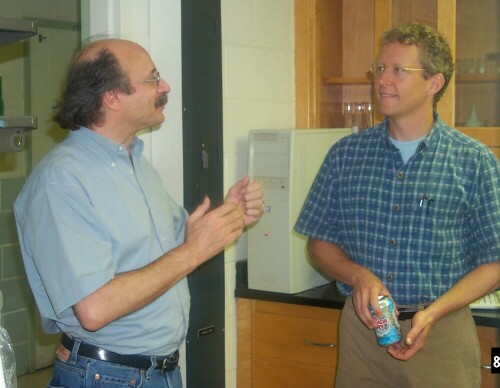 |
| L. David Roper and Bennett Greenspan discussing the Franklin Y-chromosome markers: |
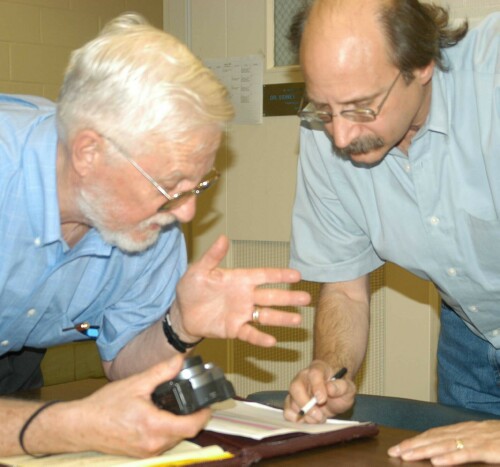 |
| Dr. David Browdy: |
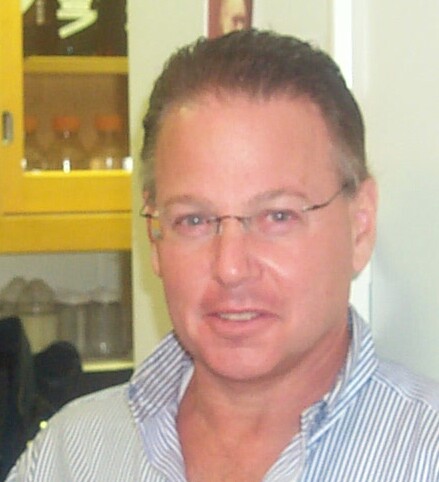 |
| John Miller and Biolase photo people: |
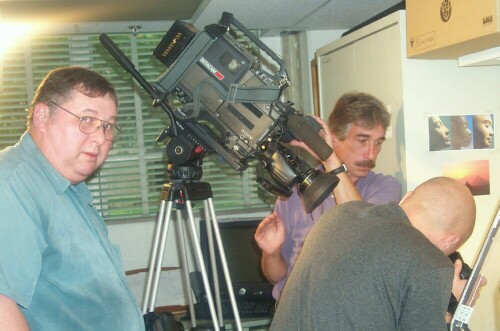 |
| The three tooth pieces after extraction from the acorn: |
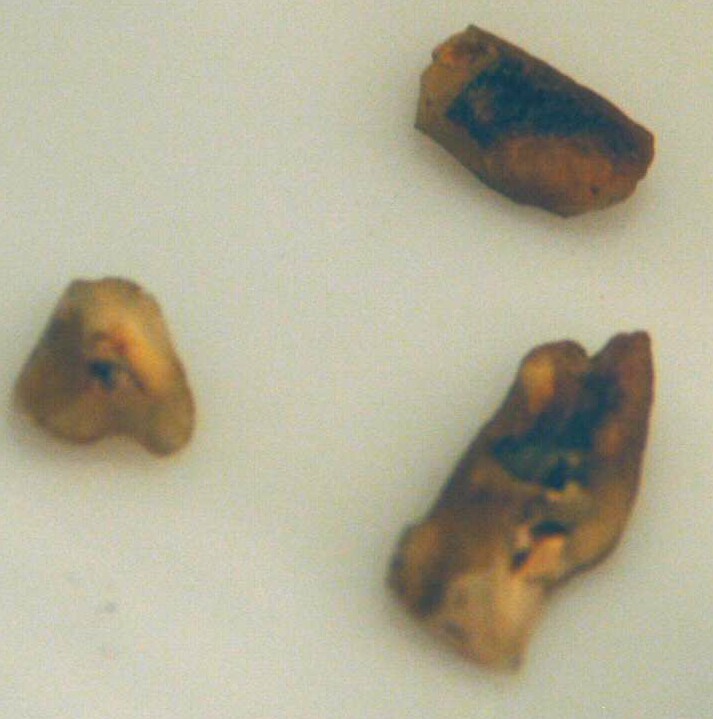 |
| The largest of the three pieces before cutting it: |
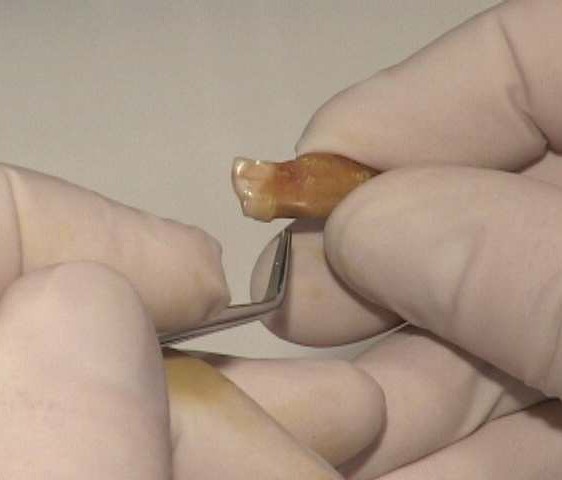 |
By gently probing the tooth crown I had surmised that the tooth was broken into at least two pieces, but probably into three pieces. Indeed the latter was what was the case. Dr. Browdy used a dental tweezer to remove the paper packing from around the tooth and, after a small amount of maneuvering of the two visible pieces of the crown, three pieces fell out of the crown. The larger part of the crown was still firmly attached to the root below it and the smaller part of the crown was broken off from its root, which is the smaller root of the lower-molar root system. Dr. Tillquist indicated that he plans to break the larger root into two pieces so that he will have three root pieces to analyze separately for possible DNA. It is interesting that the larger of the two roots is almost separated into two parts, slightly similar to the case for upper molars, which have three roots, with two quite close together. Many pictures were taken of the three pieces to aid in putting the two pieces of crown back into the gold acorn at a later date.
| Dimensions of the three pieces of the tooth. | |
| Small piece (mostly crown) | |
| Length: | 0.379 inches = 9.63 mm |
| Width: | 0.334 inches = 8.48 mm |
| Depth: | 0.207 inches = 5.26 mm |
| Medium piece (all root) | |
| Length: | 0.506 inches = 12.9 mm |
| Width: | 0.254 inches = 6.45 mm |
| Depth: | 0.159 inches = 4.04 mm |
| Large piece (crown and root) | |
| Length: | 0.778 inches = 19.8 mm |
| Root width: | 0.326 inches = 8;.28 mm |
| Crown width: | 0.277 inches = 7.04 mm |
| Root depth: | 0.198 inches = 5.03 mm |
| Crown depth: | 0.186 inches = 4.72 mm |
| Masses | |
| Tooth-Acorn | 5.28 grams |
| Acorn | 3.64 grams |
| 3 tooth pieces | 1.64 grams |
| 3 tooth crown pieces | 0.49 grams |
| 2 tooth roots | 1.15 grams |
| Paper packing | 0.10 grams |
Dr. Tillquist, Dr. Browdy and I decided to use the Waterlase dental device to cut a crown piece from the larger root. This decision was made because Dr. Tillquist noticed that an interesting part of the root extended up on side of the crown. The Waterlase could make non-linear cuts to include that interesting part in the removed root, whereas a saw cannot do such non-linear cuts.
Dr. Browdy took about 15 minutes to cut the larger root from its crown very successfully using the Waterlase. Many pictures were taken of this process and of the four pieces of the tooth: two crown pieces and two root pieces.
| Waterlase dental device and Dr. Browdy: |
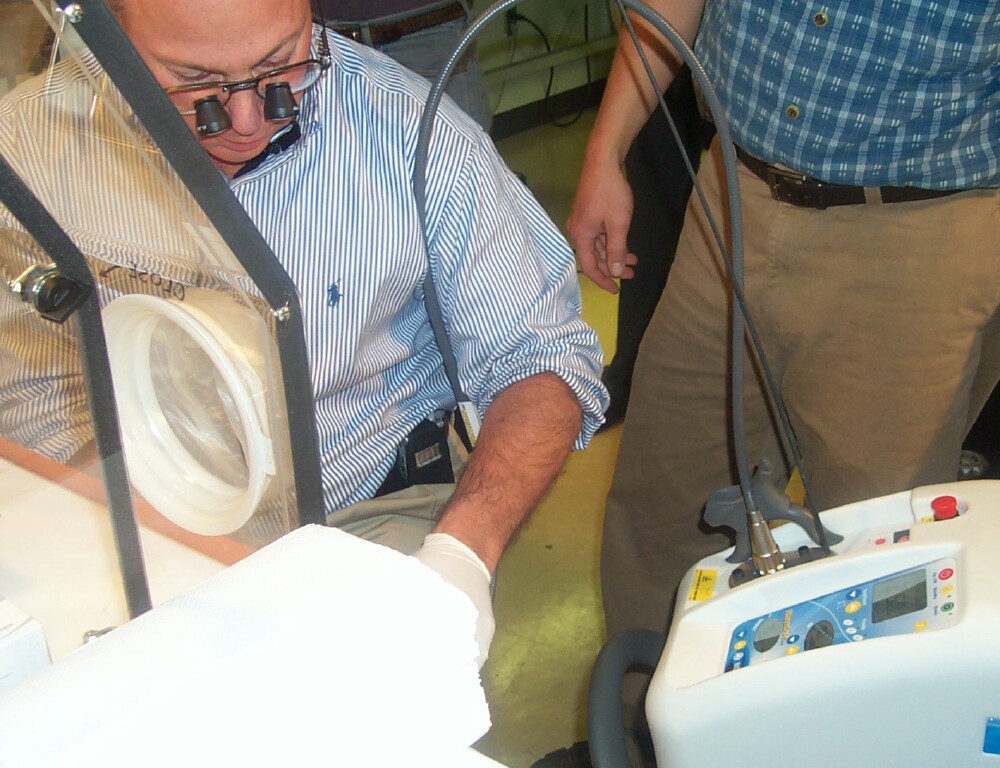 |
| Partial-crown (up) and its root before cutting by Dr. Browdy: |
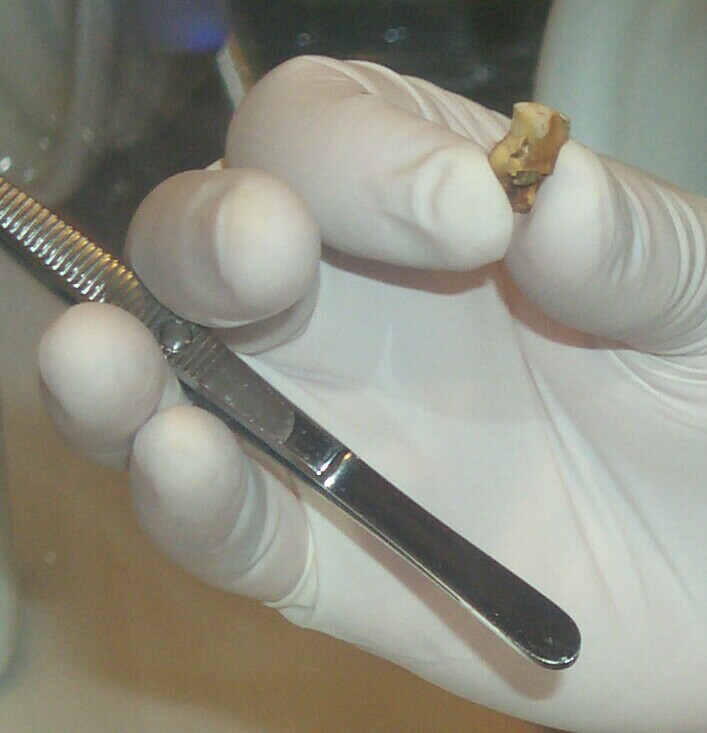 About half of the root is hidden behind his finger. |
| Dr. Browdy cutting the partial-crown from its root: |
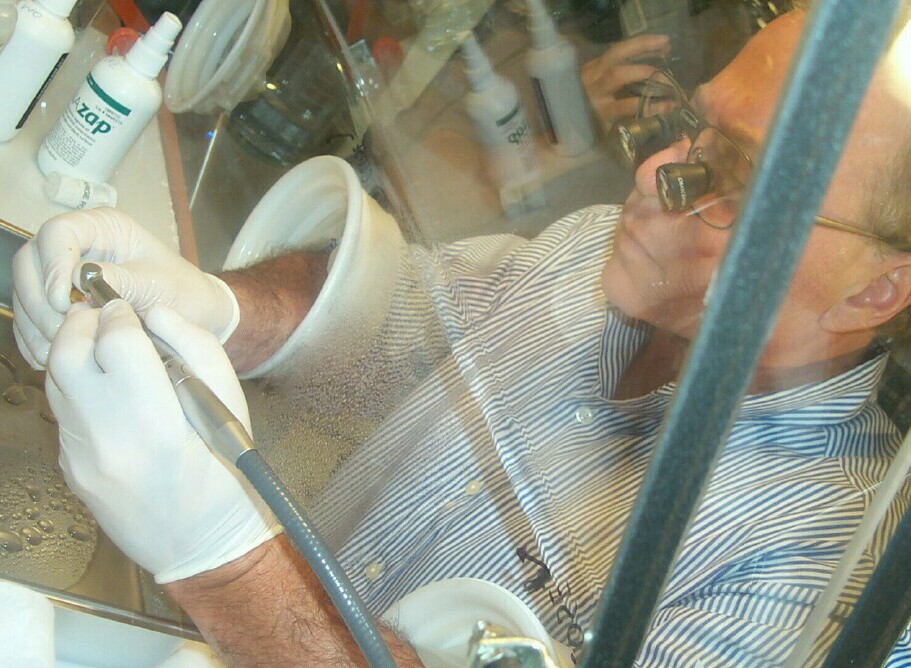 |
| Dr. Browdy cutting the crown from the root of the largest of the 3 pieces: |
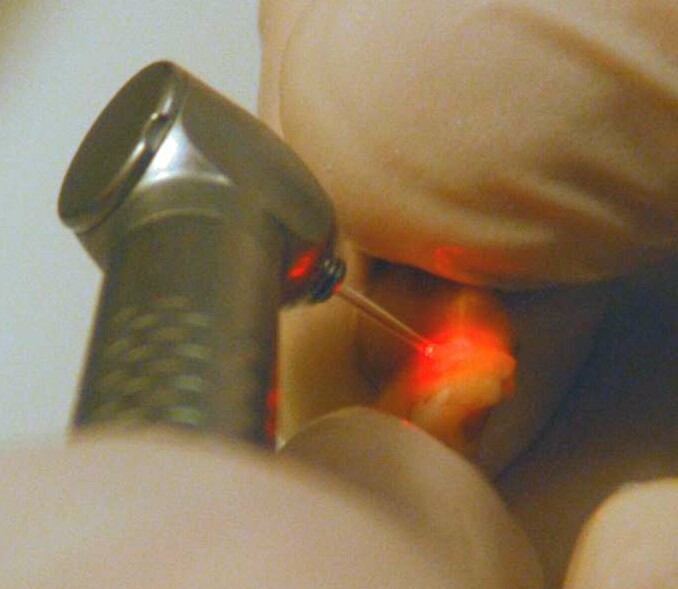 |
| Mortar-pestal to be used to grind the roots into dust. (It will be hit many times with a heavy hammer.): |
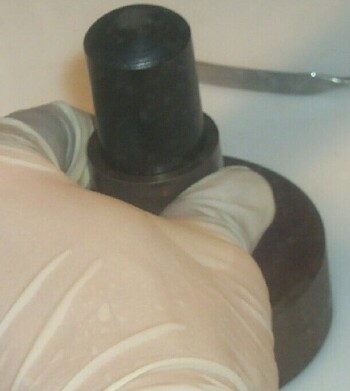 |
| Dimensions of the large piece after it was cut. | |
| Large piece (crown and
root) before it was cut |
|
| Length: | 0.778 inches = 19.8 mm |
| Root width: | 0.326 inches = 8;.28 mm |
| Crown width: | 0.277 inches = 7.04 mm |
| Root depth: | 0.198 inches = 5.03 mm |
| Crown depth: | 0.186 inches = 4.72 mm |
| Crown after it was cut from the root | |
| Wide width: | 0.350 inches = 8.89 mm |
| Narrow width: | 0.214 inches = 5.44 mm |
| Larger thickness: | 0.177 inches = 4.50 |
| Smaller thickness: | 0.090 inches = 2.29 mm |
| Tooth-acorn pieces after removing the tooth from the acorn and cutting the root from the partial acorn: |
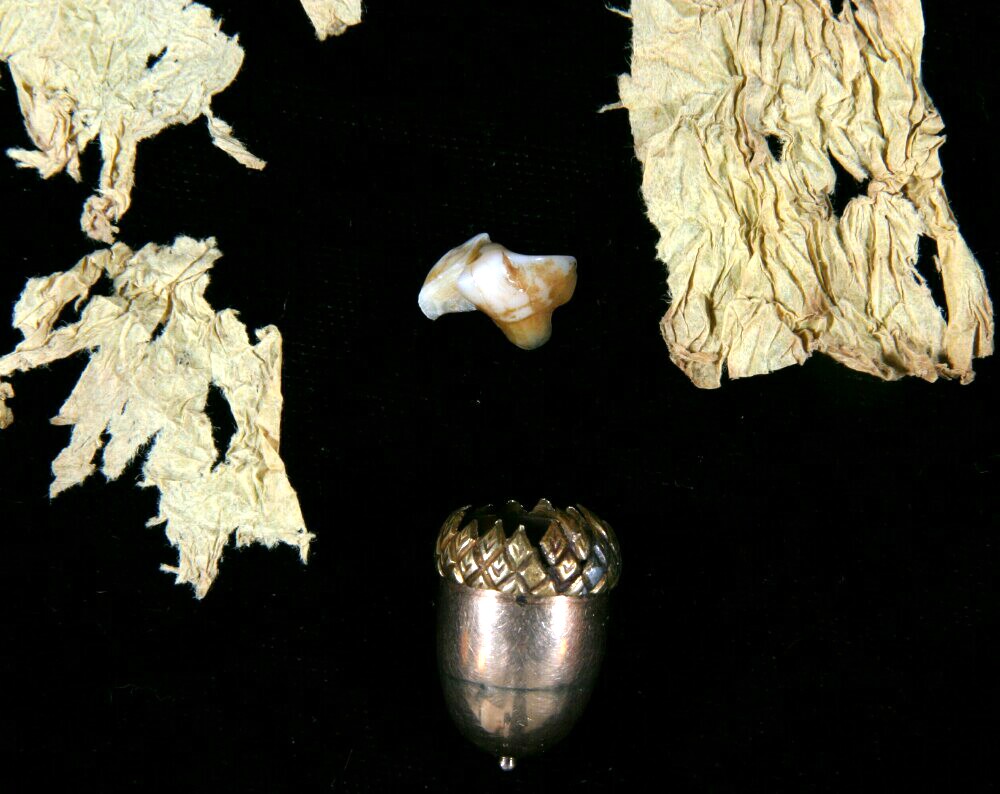 The flat pieces of paper were the packing between the acorn and the tooth. |
| Inside of acorn after removing the tooth: |
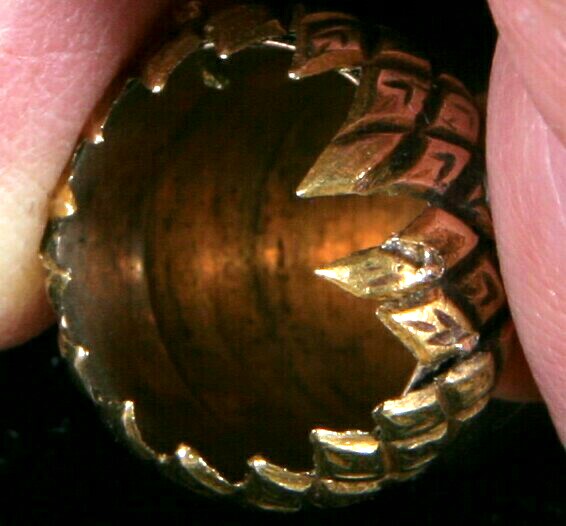 Note the imperfections in the filigree, indicating that it was hand made. |
| The two tooth pieces after cutting off the root from one of the crowns: |
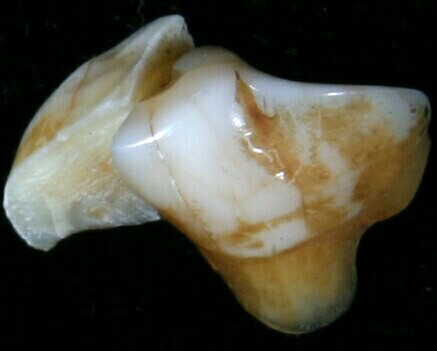 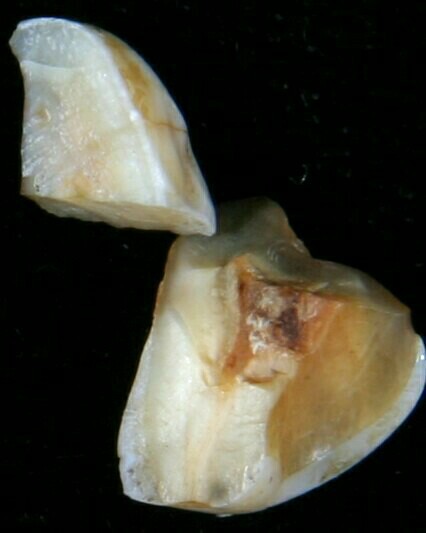 While it was being measured the tip of the small piece of crown broke off, so there are now 3 pieces of the crown: |
  |
| A scan of the largest piece of paper packing: |
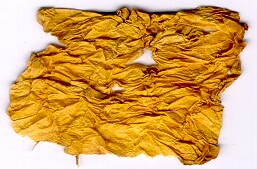 |
The three crown pieces were put back into the gold acorn in the presence of L. David Roper, manager of the tooth-acorn project, by Dr. Steven D. Spitz of Boston MA, Dr. Jack D. Rosenberg of Burlington MA and Dr. David Browdy of Lynbrook NY in Dr. Spitz's office one block from Fenway Park in Boston on 15 October 2004. A small note about the history of the tooth was laminated and put into the bottom of the acorn underneath the restored tooth, a sort of time capsule.
| Pictures taken during the restoration of the tooth into the acorn in Boston, MA on 15 October 2004: |
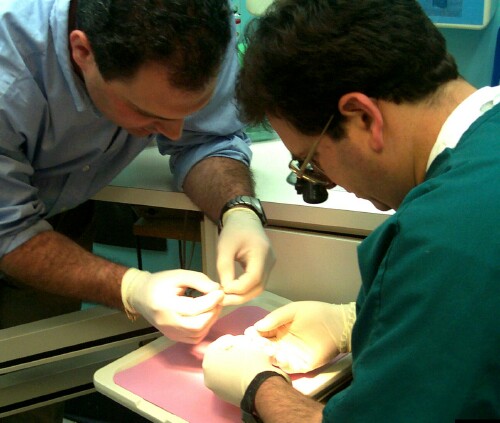 Drs. Jack D. Rosenberg and Steven D. Spitz attaching together the three pieces of the crown. |
The crown after the three pieces were attached together. |
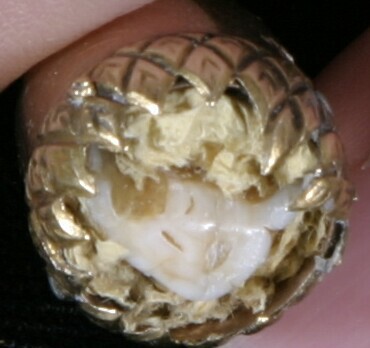 The crown restored into the acorn is shown above and below. A piece of the original paper stuffing was put back into the acorn on top of the dental filler that attached the crown to the acorn. |
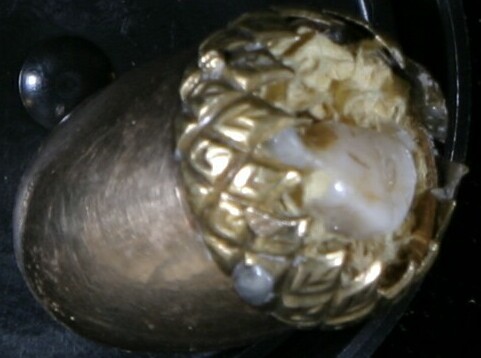 |
The restored tooth-acorn inside a display case provided by Edilberto Touron, dental prosthetic technician of Boston, MA |
| A press release about the restoration of the tooth
into the gold acorn can be read at
http://www.nickersonpme.com/news/1-29-05.html and a video about it viewed at http://www.nickersonpme.com/images/BenFranklin.wmv |
Watch this space for an eventual description of how Drs. Rosenberg and Spitz attached the three pieces of the crown and how they then attached the restored crown to the gold acorn.
An expert in paper testing, Debora Mayer, tested the paper for its content, method of manufacture and approximate age. Here is her report:
The paper is made from bast fibers, probably from linen (flax fibers) or from hemp. The fibers are very heavily beaten. The beating of the fibers produces a paper that is thin yet tough. There may be some cotton fibers present as well. Although cotton has been available since early times it is rarely found in paper until after the invention of the cotton gin (1791). You see cotton being included in paper right after the cotton gin in the 1790s and quite common after that-very common after 1800. The inclusion of cotton was the question to my colleague. He agreed there may be cotton present, but if present it is a very small percentage. The heavily beaten nature of the fibers may also be contributing to the fibers appearing like cotton. All the fibers are high cellulose containing fibers (meaning "rag" fibers) and did give a positive chemical test for high cellulose. Fibers in this group include linen, hemp, and cotton. I did not address the unusual yellow color of the paper. FTIR would be my suggestion. Based on the fiber content the paper could have been made during Franklin's time. It could also have been made later as those fibers are still in use today. However, today you would expect a similar tissue wrapper to be made with straw (after 1800) or with wood pulp (after mid 19th century). Debora Dyer Mayer Telephone: 603.433.7020; e-mail: Mayergrpnh@aol.com . The full report is FranklinBenFiberMayer.pdf .
Here are some facts about colonial paper making:
I collect all data that I can find for Franklin families worldwide. Of course, that includes the family of Benjamin Franklin (BF), statesman, which came to the USA in 1683 from Northamptonshire England. BF was born 17 January 1706 in Boston, Massachusetts. See http://www.benfranklin300.com for information about his 300th birthday. For information about the BF House in London see http://www.benjaminfranklinhouse.org/site/sections/default.html .
Benjamin had many siblings and cousins. The only known living descendants of Benjamin are descendants of his daughter Sarah Franklin Bache. I have met or communicated with thirteen of them. You might be interested in the fact that one of them is working on documentary about the descendants of BF: http://www.franklinschildren.com .
Many Franklin families claim to be related to BF. With the Y-chromosome test described below, I have been able to show the most of them are incorrect, because I have shown that they are not related to each other.
For a few years now I have been running a Franklin male-lines Y-chromosome project (http://www.roperld.com/franklingenetics.htm). One goal was to test males with surname Franklin who are known by reliable genealogy to be related to BF, either as descendants of a brother or an uncle; I have not been able to find any. So, I really went crazy and tried to find a tooth of BF to possibly test.
By chance I was contacted by a descendant of BF who had in her possession what was purported to be a tooth of BF in a gold acorn. She sent the tooth/acorn to me to have the roots cut off and tested. See http://www.roperld.com/FranklinBenDNA.htm and http://www.roperld.com/franklinbentooth.htm (this file). The tooth was removed from the acorn, the roots were cut off and the tooth was reconstructed back into the acorn.
We wanted to find Y-chromosome markers in DNA in the roots. Y-chromosomes in old DNA decomposes fairly rapidly, so the prospects were not very good to find Y markers. No Y markers were found.
However, some mtDNA SNPs were found in the tooth's roots that indicated a certain mtDNA haplogroup. I had knowledge of the mtDNA haplogroup of a woman whose genealogy indicated that she descended in a strict female line from BF's grandmother, but her haplogroup is a different one that the BF-tooth haplogroup. So, the conclusion is that either the woman's genealogy is wrong or the tooth is not BF's.
We still have one of the two roots of the that we hope to preserve for the future when improved technology is available for studying old DNA.
It is possible now to fully sequence mtDNA (all 16,569 base pairs) for $895 (http://www.familytreedna.com/description.html#mtFullSequence). I hope to raise the funds to do that for the BF tooth, assuming that is possible with the tooth's old mtDNA.
In January 2007 I was contacted by a descendant of Ben Franklin who has seen two teeth in acorns and one not in an acorn that were claimed by the family to be from the mouth of Ben Franklin. I am trying to find out where those two more teeth are and to obtain pictures of them.